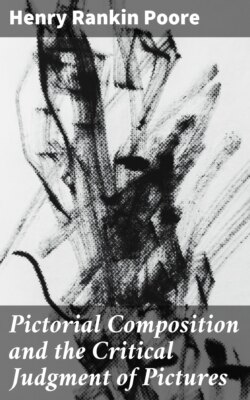Читать книгу Pictorial Composition and the Critical Judgment of Pictures - Henry Rankin Poore - Страница 10
На сайте Литреса книга снята с продажи.
VERTICAL AND HORIZONTAL BALANCE.
ОглавлениеTable of Contents
In the “Salute to the Wounded,”by Detaille, complete and formal balance on both the vertical and horizontal line is shown. The chief of staff is on one side of centre, balanced by the officer on the other, and the remaining members of staff balance the German infantry. Although the heads of prisoners are all above the horizontal line, three-fourths of the body comes below—a just equivalent—and, in the case of the horsemen, the legs and bodies of the horses draw down the balance toward the bottom of the canvas, specially aided by the two cuirassiers in the left corner. In addition to this, note the value of the placement of the gray horse and rider at left, as a means of interrupting the necessary and objectionable line of feet across the canvas and leading the eye into the picture and toward the focus, both by the curve to the left, including the black horse, and also by the direct jump across [pg 42] the picture, through the white horse and toward the real subject—i.e., the prisoners.
Much has been written by way of suggestion in composition dealing with this picture or that to illustrate a thought which might have been simplified over the single idea of balance which contains the whole secret and which if once understood in all of its phases of possible change will establish procedure with a surety indeed gratifying to him who halts questioning the next step, or not knowing positively that the one he has taken is correct.
These criticisms vaguely named “confusion,” “stiffness,” “scattered quantity,” etc., all lead in to the root, unbalance, and are to be corrected there.
Balance is of importance according to the number of units to be composed. Much greater license may be taken in settling a single figure into its picture-space than when the composition involves many. In fact the mind pays little heed to the consideration of balance until a complication of many units forces the necessity upon it. The painter who esteems lightly the subject of composition is usually found to be the painter of simple subjects—portraits and non-discursive themes, but though these may survive in antagonism to such principles their authors are demanding more from the technical quality of their work than is its mission to supply.
The first two main lines, if they touch or cross, start a composition. After that it is necessary to work upon the picture as it hangs in the balances.
[pg 43]
The inutility of considering composition in outline or in solid mass of tone as a safe first analysis of finished work is evident when we discover that not until we have brought the picture to the last stage of detail finish do we fully encompass balance. The conception which looks acceptable to one's general idea in outline may finish all askew; or the scheme of Light and Dark in one or two flat tones minus the balance of gradation will prove false as many times as faithful, as it draws toward completion. It is because of this that artists when composing roughly in the presence of nature seldom if ever produce note-book sketches which lack the unity of gradation. It is the custom of some artists to paint important pictures from such data which, put down hot when the impression is compulsory, contain [pg 44] more of the essence of the subject than the faithful “study” done at leisure.
The possibilities of balanced arrangement being so extensive, susceptible in fact of the most eccentric and fantastic composition, it follows: that its adaptability to all forms of presentation disarms argument against it. In almost every case, when the work of an accomplished painter fails to convince, through that completeness which of all qualities stands first, when, after the last word has been said by him, when, nature, in short, has been satisfied and the work still continues in its feeble state of insurrection, which many artists will confess it frequently requires years to quell, it is sure proof that way back in the early construction of such a picture some element of unbalance had been allowed.
